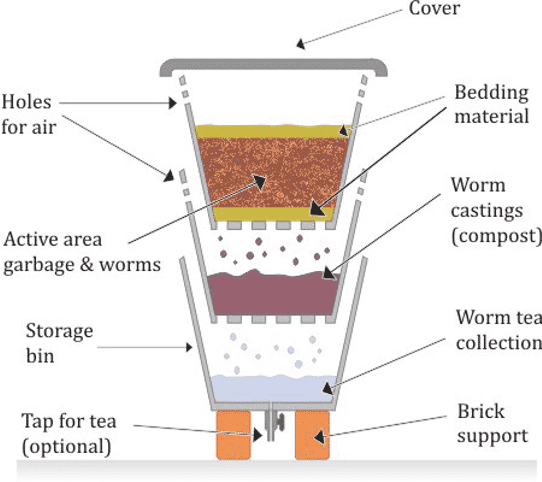Composters
Worms
Worm are a great benefit to all soil, aerating and increasing fertility. In fact, in the past land was valued by the number of worms to be found in the soil.
The process of using worms to compost organic wastes is called vermicomposting or vermiculture. Worms eat through leaves, grass clippings, manure, and almost any non-woody vegetative waste much faster than nature can break it down alone. They cannot consume animal meat or fat.
Worms leave castings behind them, a perfectly balanced fertilizer that can be added directly to the soil or added to water with the other runoff from the worm farm and sprayed on as a liquid fertilizer. This liquid fertilizer can be used as a perfectly balanced hydroponic solution (see chapter on intensive recirculating aquaculture).
Red wiggler worms are used for vermiculture and can be purchased from your local garden center or found in your garden. They must be composting worms not soil worms.
To Make A Worm Composter
- Get a tote or plastic container with a lid (worms are photophobic, so the bin should be kept covered). Drill holes in the bottom.
- Line the bottom with cardboard, straw, or other bedding material.
- Fill the bin with kitchen scraps and shredded, non-woody garden wastes and cover with more bedding material.
- Water until all the material is damp (not soggy), add some red wriggler worms, and cover.
- Ensure the material in the bin is damp and sprinkle water on if needed.
- When the waste in the bin has mostly turned to castings, get a small bucket of kitchen scraps and dump them in one corner of the bin. Leave for 48 hours.
- Scoop the scraps up in the bucket again; most of the worms will have migrated into the pile of food scraps.
- Take the castings and use in your garden as a soil amendment.
- Take three-quarters of the worms in the bucket and release them into your garden to aerate and fertilize your soil, or feed them to your fish or poultry.
- Use the remaining quarter of them to re-seed the next worm bin and repeat.
Black Soldier Flies (BSF)
Black soldier fly larvae are one of the fastest nutrient recovery mechanisms available to the small homesteader.
BSF larvae are used in composting and as food for animals. As larvae, they consume up to ten times their body weight in organic waste per day—many times more than worms can. The wastes they consume include fresh manure and nearly any non-woody organic wastes.
They can turn 100 lbs. of kitchen or garden wastes into 20 lbs. of high-grade protein and lipid animal or fish feed in a matter of days. They can even eat meat wastes, which worms cannot do.
Houseflies and blowflies cannot lay eggs in the material inhabited by black soldier fly larvae. BSFs are not a vector for disease, and adult flies have no mouthparts, meaning they cannot bite you. They are not attracted to human habitation or foods; the egg-bearing females are only attracted to rotting food or manure.
Plus, mature larvae are self-harvesting; when ready they will crawl out of the compost pile and fall onto the ground (or into your feed bucket) for easy harvesting and feed to animals. BSF larvae are over 40% protein and nearly 35% fat (dry matter weight), with nearly 5% calcium with many other trace nutrients—a powerhouse of nutrition.
And the residue left after digestion can be fed to the worms in your worm farm or used directly as a soil amendment in the garden.
However, being a tropical and subtropical insect, they require warmth. Larvae will go dormant below 50°F and above 110°F. If you live in a cold area, you may have to grow them indoors during winter. (Worms don’t have this issue.)
To Make A Black Soldier Fly Bio Digester
The Structure:
- Many different containers can be used, 55-gallon barrels, tote bins, or wooden boxes are common. Size your digester depending on the amount of waste you have to convert.
- An access opening to allow continued addition of organic wastes to feed the larvae is needed.
- An exit ramp of less than 35 degrees is required on one or both ends to allow the larvae to crawl out into a collection bucket.
- Drainage holes on the bottom of the container are required to drain the effluent out.
- Place out of direct sunlight to prevent overheating.
Operating A BSF Digester:
- Black Solder Flies are indigenous to the southern United States and Central and South America but occur in all warm, subtropical or tropical areas in the world. If you live in an area where they don’t naturally occur, you can order larvae online from suppliers, which will hatch and become your future breeding stock. They are sometimes called phoenix worms commercially.
- Soldier flies lay their eggs near rotting material. Be sure to allow access to the waste material.
- Add kitchen and farm wastes when you have them, up to 12 inches deep.
- Make sure the ramp is accessible for the larvae and not too steep.
- Check moisture regularly and sprinkle with water to keep the pile moist as needed.
- Don’t add more than 20% meat or lipids to the mix until you are proficient BSF operator.

